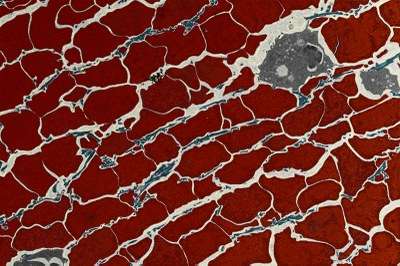Researcher discusses venous thrombosis findings

A conversation with Alisa Wolberg is not for the faint of heart. That's not to say that the trained biologist's demeanor is particularly fearsome; quite the contrary, she is enthusiastic and knowledgeable, generous with tidbits of scientific trivia and history whenever she alights on her favorite topic. The problem – some might find at least – is that Wolberg's favorite topic is blood: how it travels through hundreds of circuitous miles of arteries, veins, and capillaries to deliver oxygen and vital nutrients to every cell in the body; how a rare bleeding disorder passed down through generations of royalty helped to destroy Russia's Imperial Empire; how the opposite problem – dangerous blood clots known as venous thrombosis – strikes more than a million Americans each year.
Wolberg's laboratory studies the molecular, cellular, and biochemical mechanisms governing the formation of blood clots. She is intimately familiar with the coagulation cascade, the sequence of events that on paper look like a stone skipping across the surface on a pond, but in actuality represent the lineup of different protein factors activated on the path from a cut to a clot. In recent years, she has used funding from UNC's Clinical and Translational Science Awards (CTSA) to focus on one of these proteins, called factor XIII.
Factor XIII may be the most overlooked member of the coagulation cascade. Once thought to play a minor role in stabilizing fibrin, the protein that forms the fibrous scaffolding of blood clots, it is now known to be crucial to blood coagulation, wound healing, and even pregnancy. Complications of abnormal blood clotting, which occur during heart attacks, are the number one killer of Americans. More people die of arterial thrombosis than from cancer; more people die from venous thrombosis than from accidents.
Blood thinners like Warfarin and Plavix effectively reduce the body's ability to make blood clots, but in doing so create a significant risk of catastrophic bleeding. These terrifying trade-offs have prompted researchers to search for safer alternatives. In 2014, Wolberg discovered that factor XIII controls the size and the makeup of blood clots. She showed that eliminating the protein reduces the number of red blood cells trapped in a clot, essentially shrinking the clots by 50 percent. The finding, which was published in the Journal of Clinical Investigation, singled out factor XIII as a promising therapeutic target for preventing thrombosis.
"If we can develop a treatment that exploits this discovery to reduce the size of blood clots, it could represent a whole new approach to treating thrombosis that's different from anything else on the market," says Wolberg, who is an associate professor of pathology and laboratory medicine. "We think reducing factor XIII activity could be helpful to a large number of people, perhaps including some who cannot take existing 'blood-thinning' medications."
Wolberg has spent years trying to understand factor XIII's involvement in the formation of blood clots. Factor XIII helps to crosslink the collection of fibrin threads – each with the elasticity of spider web silk – to form a kind of web or net surrounding a blood clot. Wolberg found that this net normally traps millions of red blood cells, but when there isn't factor XIII, many of these red blood cells are squeezed out as the clot contracts. The result is a much smaller clot. When it comes to blood clots, size does matter, and having a smaller footprint means a clot is less likely to plug up the circulation and cause venous thrombosis.
"This work is a wonderful example of how a modest pilot investment can lead to new insights regarding the role of a coagulation protein that we all learned about in medical school," says Tim Carey, co-principal investigator of the North Carolina Translational and Clinical Sciences (NC TraCS) Institute, home of UNC's CTSA. "These new insights will lead to additional projects to improve patient care for the common and vexing problem of thrombosis."
Wolberg has tested a number of drugs in both human blood and in mouse models of blood disorders to see if she can generate smaller, safer clots. Some of these had too many off-target effects, blocking a bunch of other proteins besides factor XIII. Others showed promise in initial studies in test tubes, but do not circulate in the blood long enough to test in mice.
Recently, Wolberg partnered with researchers in the RTI Early Phase Drug Discovery Program to develop a greatly expanded, rational approach to designing drugs that target factor XIII. The collaborators are canvassing factor XIII and its interaction with fibrin for contact points that could be blocked with new drugs. Then they'll use computational methods to screen commercial compounds and small molecules to identify those with the most potential before synthesizing and testing them in the laboratory.
It is an ambitious endeavor, but one that Wolberg thinks could have a tremendous impact on the prevention of venous thrombosis, not only saving lives but also reducing the $20 billion in health care costs associated with the affliction. Even as she becomes mired in the details of chemical structures and coagulation cascades, Wolberg never loses sight of that ultimate goal.


















